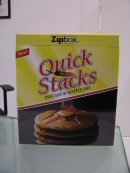Sustainability a winner in Las Vegas

Pack Expo attendance up
By Pan DemetrakakesChief Editor
Some more or less random thoughts on Pack Expo Las Vegas:
• As anyone who has ever been to a trade show knows, attendance is a universal conversational topic, like the weather. Time and again, Pack Expo exhibitors expressed gratified surprise at how good attendance was, compared with previous shows (and with their expectations). The official total came in at just under 23,000 attendees, making it the second-best PELV ever in that regard. Could this be a sign of good (or at least less bad) economic times to come?
• At the Packaging Hall of Fame induction ceremony, Dennis Young of Michigan State University was the last inductee to speak, and he got the biggest laugh of the night. He remarked that going last was always fraught with danger because other people take all the good points, then pretended to shuffle through his 3x5 cards, going, “Pat [Helm] did a great job with this, Jim [Scott] did this, Mark [Jacobson] covered that...” He then set them down, looked up and added, “So in conclusion...”
As far as an overarching theme on the show floor, I couldn’t find anything that hasn’t been around for awhile (or forever): sustainability, efficiency, cutting costs, etc. But as always, the floor was full of interesting products. Here are a couple:

The Zip Box combines paperboard with a flexible top that squares off.
•Ampac Flexiblesis doing some interesting things with premade pouches. Its E-Z Zip pouch has two innovations: All of the zipper is on one side of the premade bag, making it easier to handle and fill; and the zipper is exposed when the consumer tears open a narrow strip covering it. The latter means no more tearing off the top of the pouch, which is convenient for consumers and adds billboard space.
• With delta robots having come off patent in the U.S. last year, more suppliers are adding them, for more applications.Adept Technologyhas a four-armed version that’s OK’d for USDA (i.e., meat and fish) applications, with certain components in nickel-plated steel. The end effector can be dunked right into cleaning solution during sterilizing, and the unit is powerful enough to move around whole chickens.

Sustainability a winner in Las Vegas
by Rick LingleExecutive Editor
Sustainability was by far the odds-on favorite as the dominant topic heading into Pack Expo Las Vegas (PELV) 2009. After all, the show mirrors the key drivers in packaging, plus eco-friendly developments were one of the key points of interest in Chicago’s Pack Expo last year.
True to form, sustainability ruled the show’s successful three-day run at the Las Vegas Convention Center. But what may have provided some surprises was the extent, frequency, and the variety of ways that the concept cropped up throughout the exhibits-machinery, materials, and services-and conference. Here are some from-the-show observations:

"Grab-Pack" can be used to replace corrugated trays.

The Advantage from Zip-Pak uses less material than traditional slider-zippers.
Variations on reuse and recycling were also evident.Presto Productsshowcased its zipper rollstock spool return program. It relies on spools specifically engineered to be easily disassembled into three components via a pull-strip that breaks it down for compact return. Marketing manager Thomas Winter says the one-year-old program has been embraced by a high percentage of its customers.
Zip-Pak, which also offers a spool recycling program, unveiled its new source-reduced Advantage zipper that’s 40% the size of its normal zipper. It is intended for pack sizes of 2 pounds or less and will be available before year’s end, according to Zip-Pak’s Elizabeth Schaeffer.
Stretchwrapper supplierLantechchairman Pat Lancaster cautioned that packagers should be aware of the potentially negative downstream effects of source reductions and material eliminations. Overly zealous changes can lead to less protection and a subsequent increase in product damages during distribution that may offset the intended environmental benefit.
Energy efficiency was a reoccurring theme with machinery vendors. At the booth ofSchneider Packaging Equipment, director of sales and marketing Terry Zarnoski demonstrated the company’sRockwell AutomationPanelView Plus 1500 human-machine interface debuting on the company’s Model HCP 10 horizontal casepacker. Besides showing Overall Equipment Effectiveness (OEE), RA’s PowerMonitor 1000 software provides energy monitoring data. while the machine’s added servos versus the mechanical drives of earlier models can reduce overall energy usage.
Tnashowed off the “roflo 3” servo-driven product conveying system, which uses only 15% of the force of traditional vibrating feeders and recaptures energy leftover from the machine stroke. It also uses “virtual gate” technology to eliminate hard-to-clean mechanical gates and can direct product in more than one direction using gentle, high-throughput engineering.
The use of energy recapture was also heard during a conference presentation by Karl Tragl, executive VP of sales forBosch Rexroth. Tragl recommended that plants employ right-size machines and avoid wasteful over-engineering. He pointed to the use of regenerative energy capture in motors and drives, which, along with compressors and other auxiliary equipment, comprise just over two-thirds of a production plant’s energy demands. The timing could not be better: Tragl noted that energy costs were up 32% the last few years. “I expect kilowatt costs to increase steadily the next few years,” he added.
